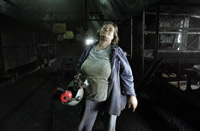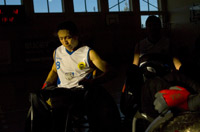8/3/2010
Exhibition of 36 students and graduates of the Institute of Creative Photography from Polish Silesia
 |
| Arkadiusz Gola |
Exhibition of 36 students and graduates of the Institute of Creative Photography from Polish Silesia
Katowice, Galeria Rondo Sztuki, Rondo im. Gen Zietka 1, March 11 – April 14, 2010. Curator Anna Sielska. Organised by the Academy of Fine Arts in Katowice.
 |
| Rafal Milach |
 |
| Krzysztof Goluch |
So close and so far. A title from one of Jindrich Streit's books, in a great way mirrors the Polish-Czech relations. At first, it seems that as close neighbours we know everything about each other, after all, we can communicate without a translator, and in the middle of stormy Europe we went through a lot together. We know the culture and artists of our neighbouring countries. Bohumil Hrabal, Andrzej Wajda, Miloš Forman or Tadeusz Kantor have been and still are admired on both sides of the border. Do the Czechs, however, truly know what is happening in terms of modern Polish literature, and can the Poles orient themselves in regards to our southern neighbours' visual arts of today? I'm afraid that in these departments we are further from one another than during the times of isolation from the western world before the fall of the Berlin Wall.
One of the few exceptions of today is photography. Here a close connection has existed for a long time. For example a classic in Czech photography Frantisek Drtikol had one of his first personal exhibitions in Warsaw already in 1929. In 1958, an exhibition of a Polish photo-reporter F. A. Kaczkowski inaugurated the grand opening of Prague's Fotochema, Europe's oldest photo-gallery. Edward Hartwig's monograph appeared in Prague in 1964. Many of the Czech photographers who found it difficult to organize exhibitions domestically under the communist regime, regularly showed their work in the Foto Medium Art Gallery in Wroclaw, at the Photographic Confrontations in Gorzów Wielkopolski, or in the “pf” Gallery in Poznan. Exhibitions also took place thanks to the help of people such as Jerzy Olek, Stefan Wojnecki, or Janusz Nowacki. The Prague's FAMU, (Film and Television School of Academy of Performing Arts), counting among its graduates a few Poles, had its share in forming the Polish-Czech relations as well. The Czech Photographers Association School of Artistic Photography had a big influence, too. One of the first graduates here was Wojciech Praźmowski.
Today, however, when speaking of Polish-Czech relations one mostly thinks of the Institute of Creative Photography of the Silesian University in Opava. At the beginning, there was one or two Polish students each year, but once Piotr Szymon joined their numbers started growing in a record time. Piotr was a great advertisement for our school, and thanks to his authority as well as friendly attitude he became a sort of father-figure to the Polish students in Opava. He gladly offered them his advice of an older and more experienced colleague, helped solve problems concerning minor incidents when the Czech beer or the Polish vodka didn't quite agree with one of them resulting in a missed morning lecture during their weekend meetings in Horní Bečva in Beskidy Mountains. Due to the fact that Piotr Szymon lived in Katowice, it was only natural that the majority of Polish students came to Opava from Silesia. Some of them had already formed their creative self, but to most, it was the school, workshops, and above all the pedagogues and fellow students that helped them establish their own style and place in the world of photography.
Over time the institute became a phenomenon in Poland. Its system of studies that joins intensive consultations with continuing and distance education, to a great degree inspired the Academy of Fine Arts in Poznan which adopted this system for its own continuing education department. Many of the Polish graduates became the best photo-reporters at the leading magazines and agencies. Others work in the position of pedagogues at art schools or as editors responsible for the quality of the published images. Still others keep on succeeding in applied photography or run photo galleries and festivals. Above all, however, they obtained a significant stand in the Polish contemporary photography and in a noticeable way they participate in its revolutionary changes after decades of the conceptual and inter-medial rule. This way they take part in creating the Polish “new document” as well as in the rebirth of the photographic portrait; they brought a fresh breath of air into photography connected with fashion and advertisement; they have created examples of an inventive use of new technologies. And it's no longer just Silesians, many of todays students at the Institute of Creative Photography come from Bialystok, where Grzegorz Dąbrowski played a similar role to that of Piotr Szymon in Katowice, but also from Warsaw and Krakow. The school where today there are students not only from Czech Republic, Slovakia, and Poland, but also from Japan, Italy and Russia clearly has an international character. Poles, however, still play the major role
Students from Silesia still play a significant role among them. A convincing proof for that is this exhibition, which sampling the creations of 36 authors presents the most varied subject matters and styles. One thing is visible at first glance, namely a great number of works showing modern Silesia: the work of miners; cities suffering from the reduction in the heavy industry production and currently coming back to life with new hopes; the deep sense of faith; the traditional human relations; old people surprised by the revolutionary changes and the youth for whom the new way of life is something natural.
While leafing through the catalogue's template I was surprised myself as to how many good photographers from the same region have studied and still study at our school, and how many from them find time for their own creative work even years after graduating. It was a very nice surprise. Someone who never organized an exhibition as this one, and never worked on a catalogue this size, probably would not understand just how much work goes into it. Anna Sielska, Arkadiusz Gola and their work partners deserve great appreciation for the enthusiasm with which took upon themselves the challenge of collecting, selecting and presenting the works of their Silesian colleagues from our school. Their exhibition is also a very precious contribution into the fact that at least in the domain of photography Poles and Czechs are very close.
Vladimir Birgus
Head of the Institute of Creative Photography,¨
Silesian University in Opava

